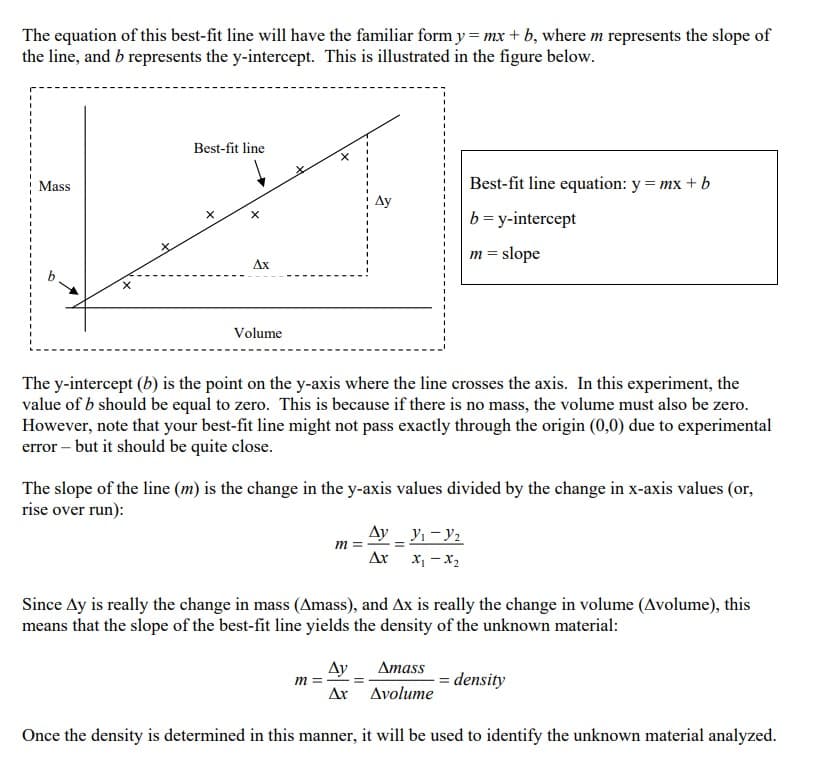Each pair of mass and volume values (for each cylinder) will be plotted on a scatter plot, with mass on the axis and volume on the x-axis. A best-fit line will then be applied to the plotted data. How will you calculate the value of the slope of this best-fit line? How will the value of the slope help you identify the unknown material that the cylinders are made of?
Each pair of mass and volume values (for each cylinder) will be plotted on a scatter plot, with mass on the axis and volume on the x-axis. A best-fit line will then be applied to the plotted data. How will you calculate the value of the slope of this best-fit line? How will the value of the slope help you identify the unknown material that the cylinders are made of?
Chemistry & Chemical Reactivity
10th Edition
ISBN:9781337399074
Author:John C. Kotz, Paul M. Treichel, John Townsend, David Treichel
Publisher:John C. Kotz, Paul M. Treichel, John Townsend, David Treichel
Chapter1: Basic Concepts Of Chemistry
Section: Chapter Questions
Problem 27RPS: To determine the average mass of a popcorn kernel, you collect the following data: Plot the data...
Related questions
Question

Transcribed Image Text:b. Each pair of mass and volume values (for each cylinder) will be plotted on a scatter plot, with mass on the y-
axis and volume on the x-axis. A best-fit line will then be applied to the plotted data.
How will you calculate the value of the slope of this best-fit line?
How will the value of the slope help you identify the unknown material that the cylinders are made of?

Transcribed Image Text:The equation of this best-fit line will have the familiar form y = mx + b, where m represents the slope of
the line, and b represents the y-intercept. This is illustrated in the figure below.
Mass
Best-fit line
+
Ax
Volume
Ay
The y-intercept (b) is the point on the y-axis where the line crosses the axis. In this experiment, the
value of b should be equal to zero. This is because if there is no mass, the volume must also be zero.
However, note that your best-fit line might not pass exactly through the origin (0,0) due to experimental
error - but it should be quite close.
The slope of the line (m) is the change in the y-axis values divided by the change in x-axis values (or,
rise over run):
m=
m =
Best-fit line equation: y = mx + b
b=y-intercept
m = slope
AyY₁-Y₂
=
x₁ - x₂
Ax
Since Ay is really the change in mass (Amass), and Ax is really the change in volume (Avolume), this
means that the slope of the best-fit line yields the density of the unknown material:
Ay
Ax
Amass
Avolume
Once the density is determined in this manner, it will be used to identify the unknown material analyzed.
= density
Expert Solution
This question has been solved!
Explore an expertly crafted, step-by-step solution for a thorough understanding of key concepts.
This is a popular solution!
Trending now
This is a popular solution!
Step by step
Solved in 2 steps with 2 images

Knowledge Booster
Learn more about
Need a deep-dive on the concept behind this application? Look no further. Learn more about this topic, chemistry and related others by exploring similar questions and additional content below.Recommended textbooks for you

Chemistry & Chemical Reactivity
Chemistry
ISBN:
9781337399074
Author:
John C. Kotz, Paul M. Treichel, John Townsend, David Treichel
Publisher:
Cengage Learning

Chemistry by OpenStax (2015-05-04)
Chemistry
ISBN:
9781938168390
Author:
Klaus Theopold, Richard H Langley, Paul Flowers, William R. Robinson, Mark Blaser
Publisher:
OpenStax

Chemistry: The Molecular Science
Chemistry
ISBN:
9781285199047
Author:
John W. Moore, Conrad L. Stanitski
Publisher:
Cengage Learning

Chemistry & Chemical Reactivity
Chemistry
ISBN:
9781337399074
Author:
John C. Kotz, Paul M. Treichel, John Townsend, David Treichel
Publisher:
Cengage Learning

Chemistry by OpenStax (2015-05-04)
Chemistry
ISBN:
9781938168390
Author:
Klaus Theopold, Richard H Langley, Paul Flowers, William R. Robinson, Mark Blaser
Publisher:
OpenStax

Chemistry: The Molecular Science
Chemistry
ISBN:
9781285199047
Author:
John W. Moore, Conrad L. Stanitski
Publisher:
Cengage Learning

Chemistry for Engineering Students
Chemistry
ISBN:
9781337398909
Author:
Lawrence S. Brown, Tom Holme
Publisher:
Cengage Learning

Chemistry & Chemical Reactivity
Chemistry
ISBN:
9781133949640
Author:
John C. Kotz, Paul M. Treichel, John Townsend, David Treichel
Publisher:
Cengage Learning

Living By Chemistry: First Edition Textbook
Chemistry
ISBN:
9781559539418
Author:
Angelica Stacy
Publisher:
MAC HIGHER